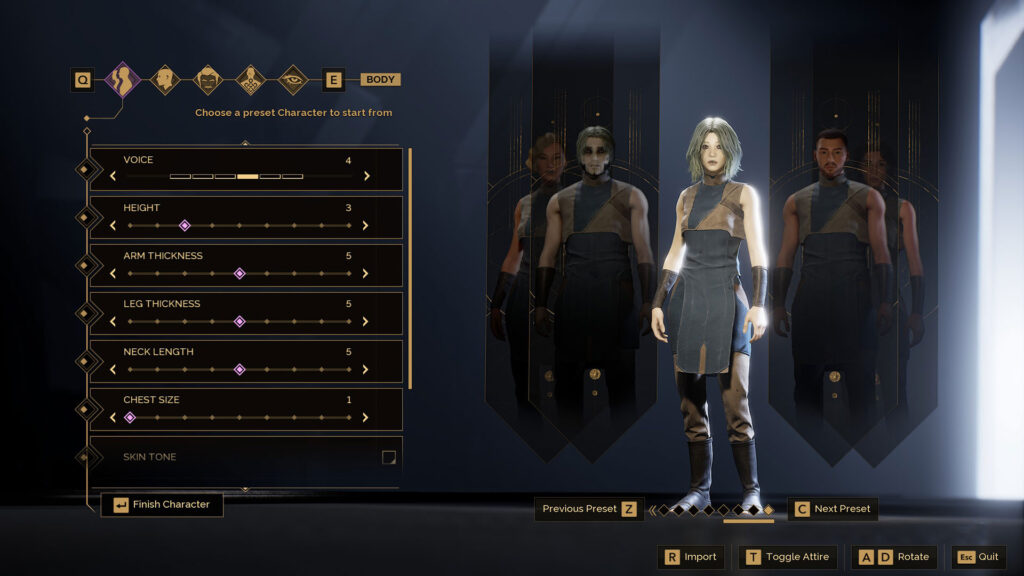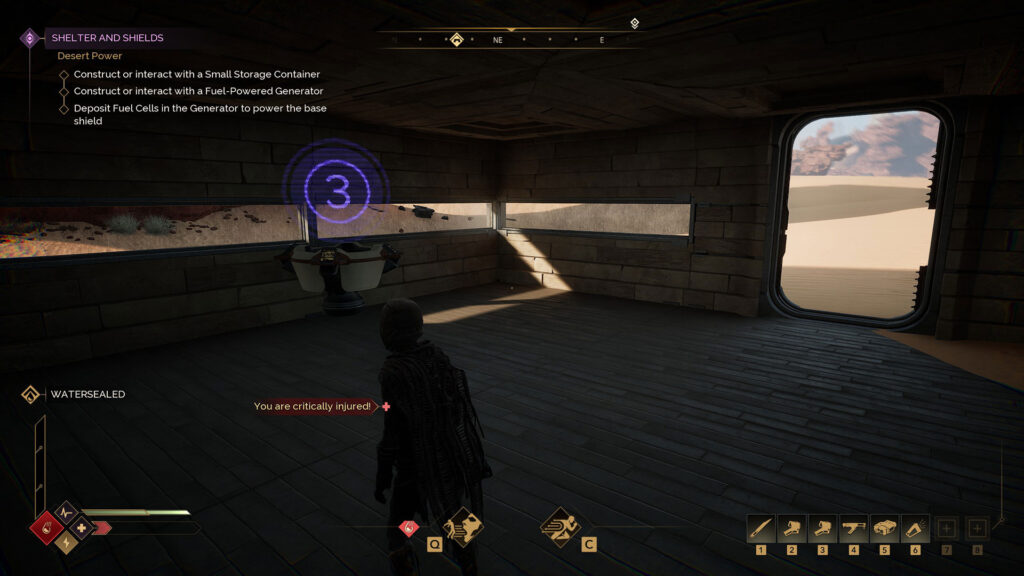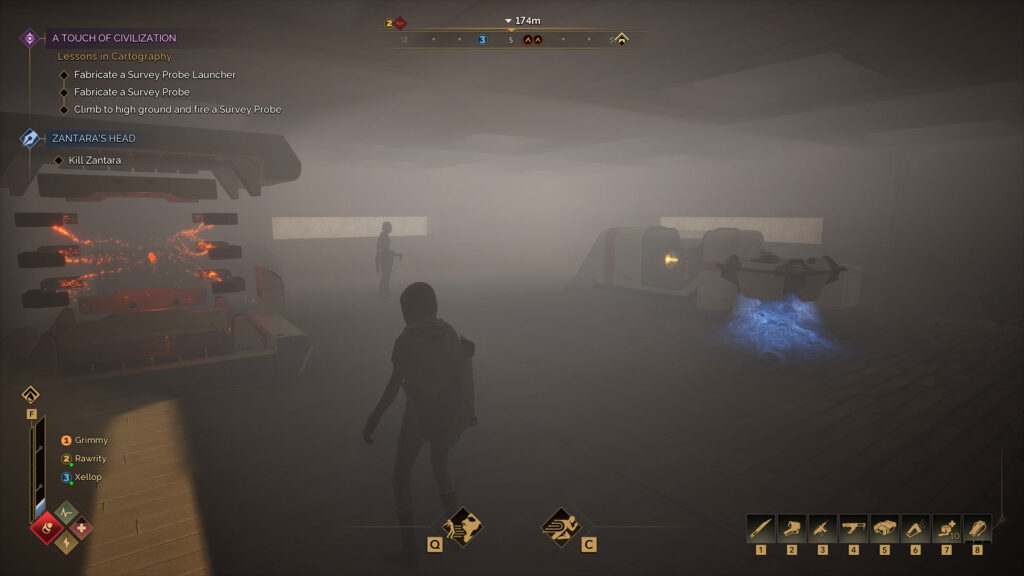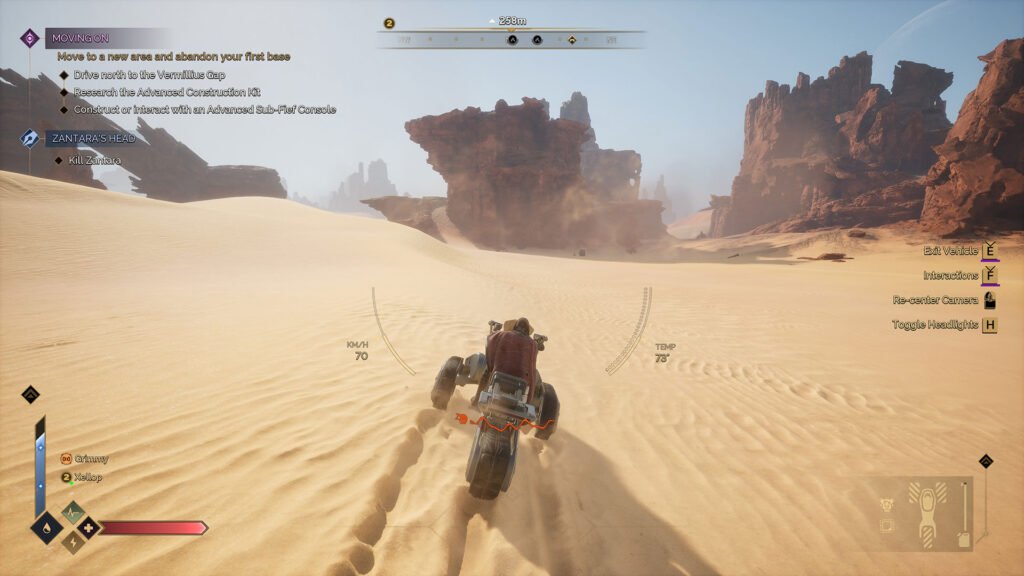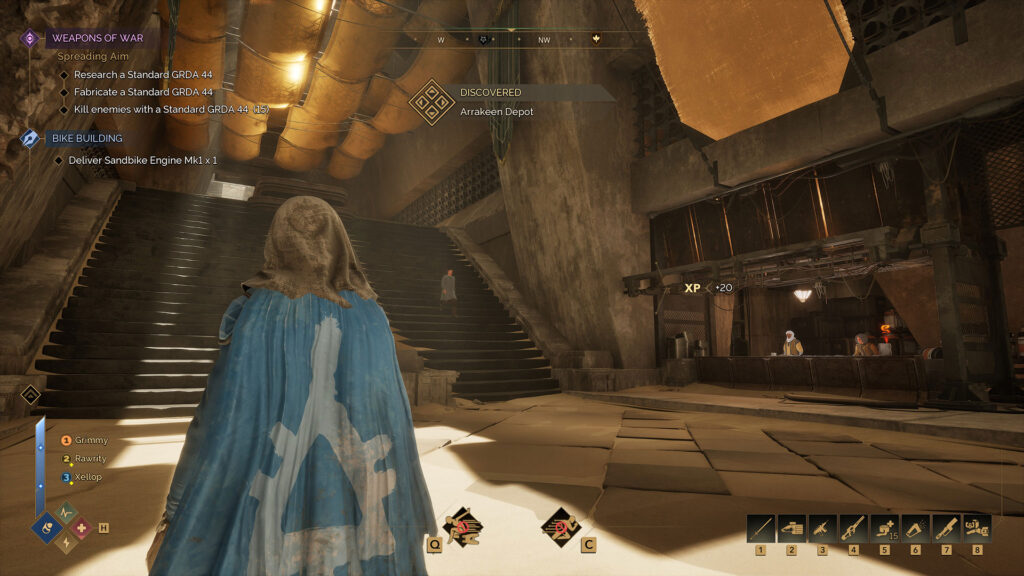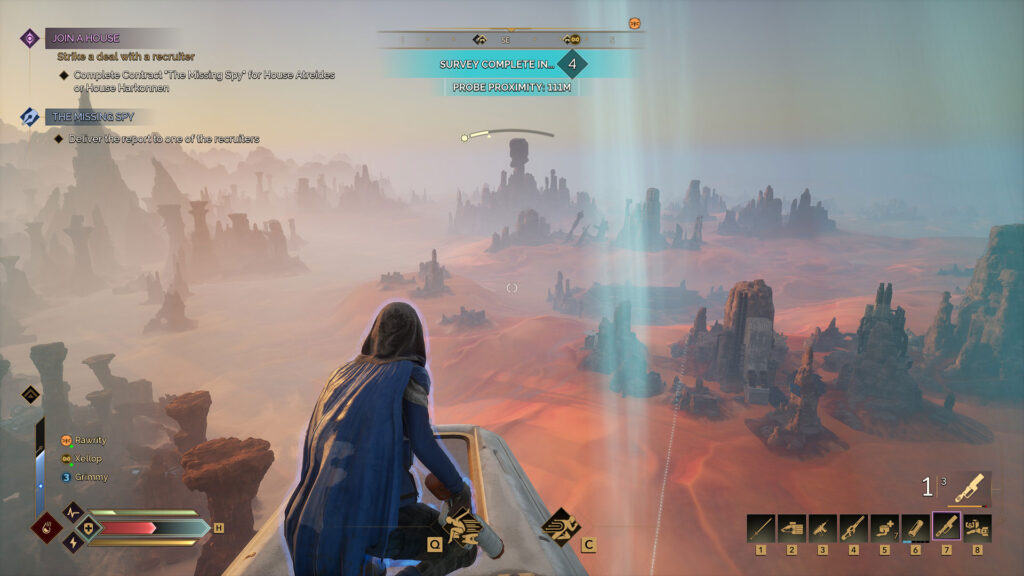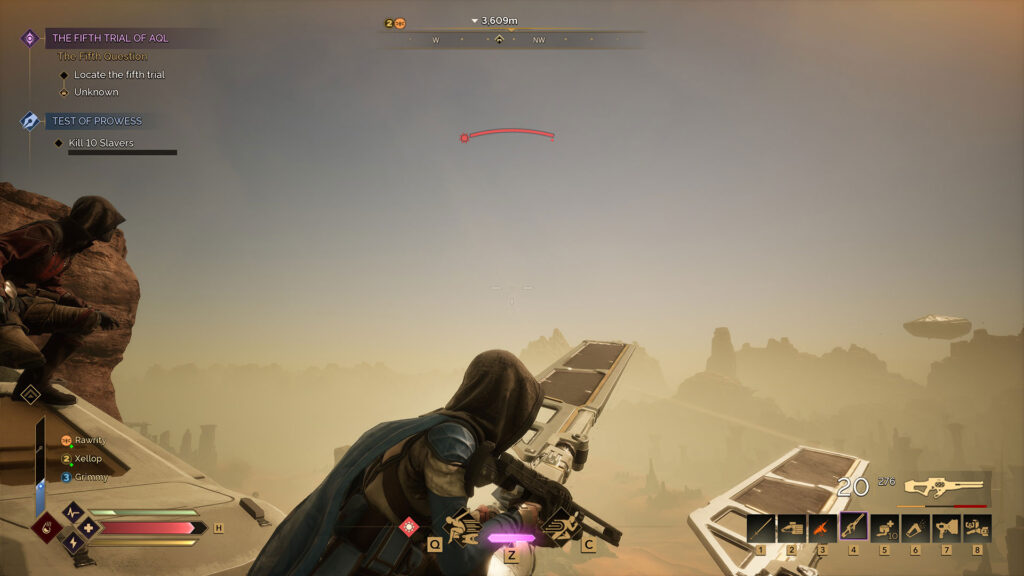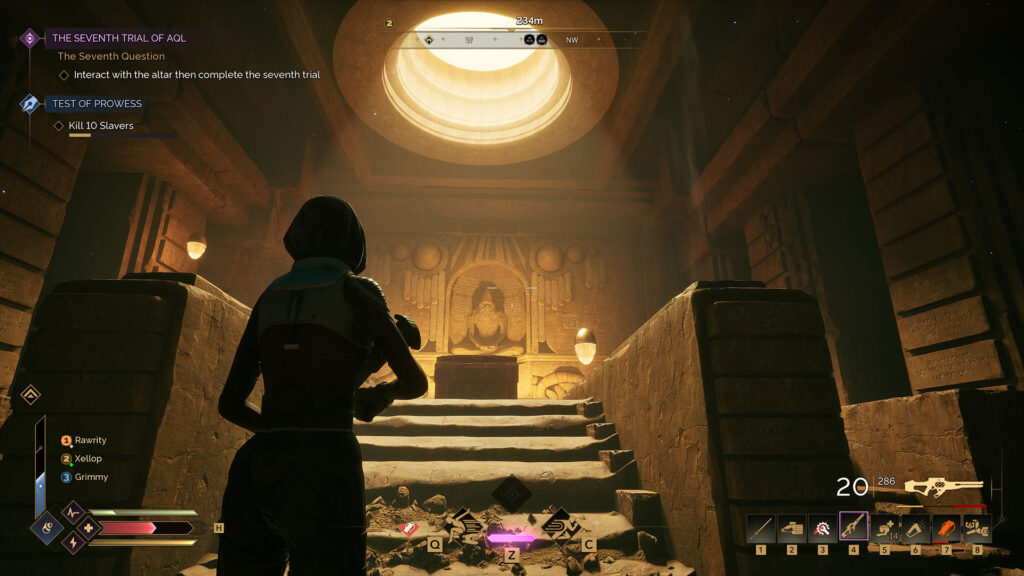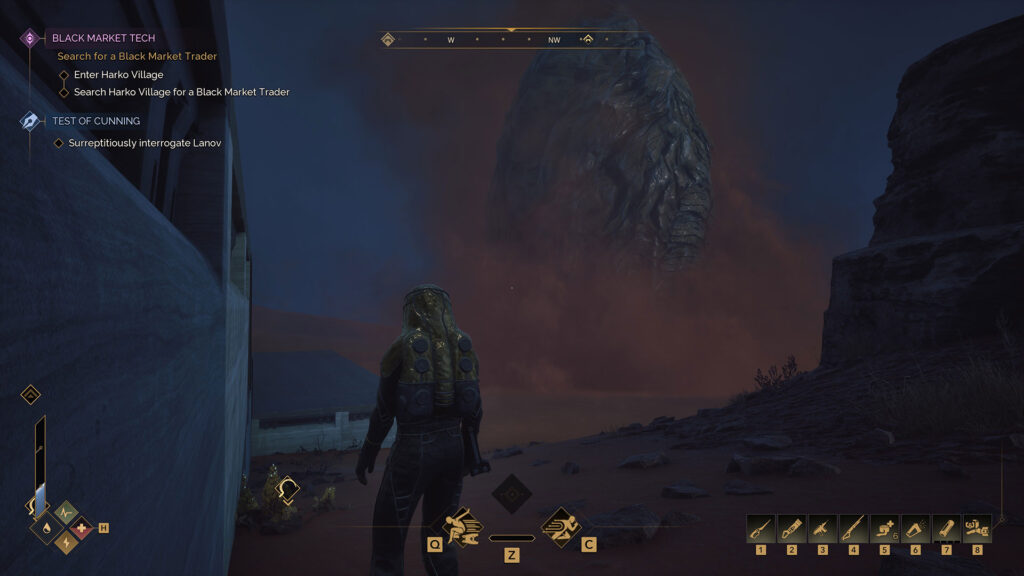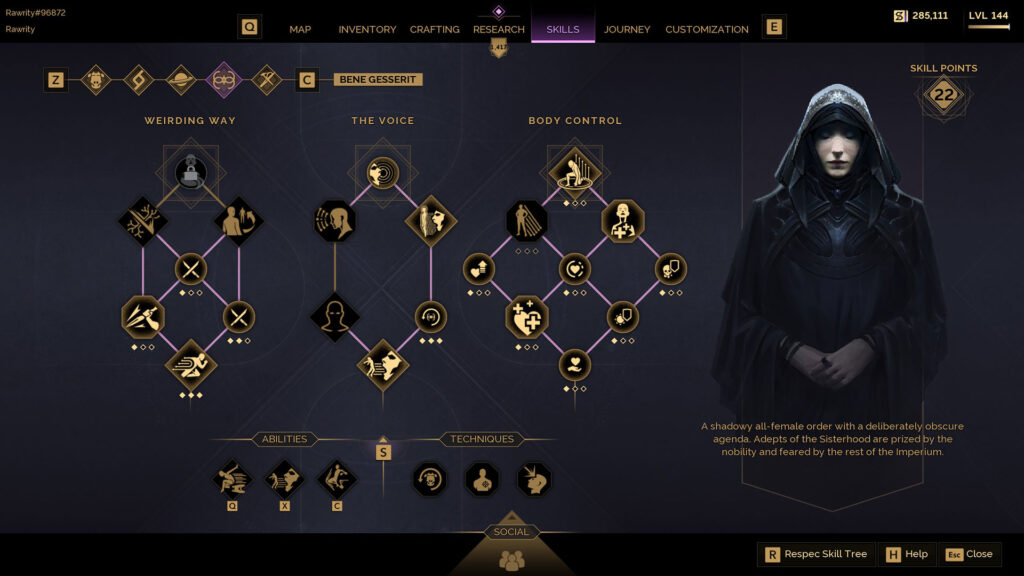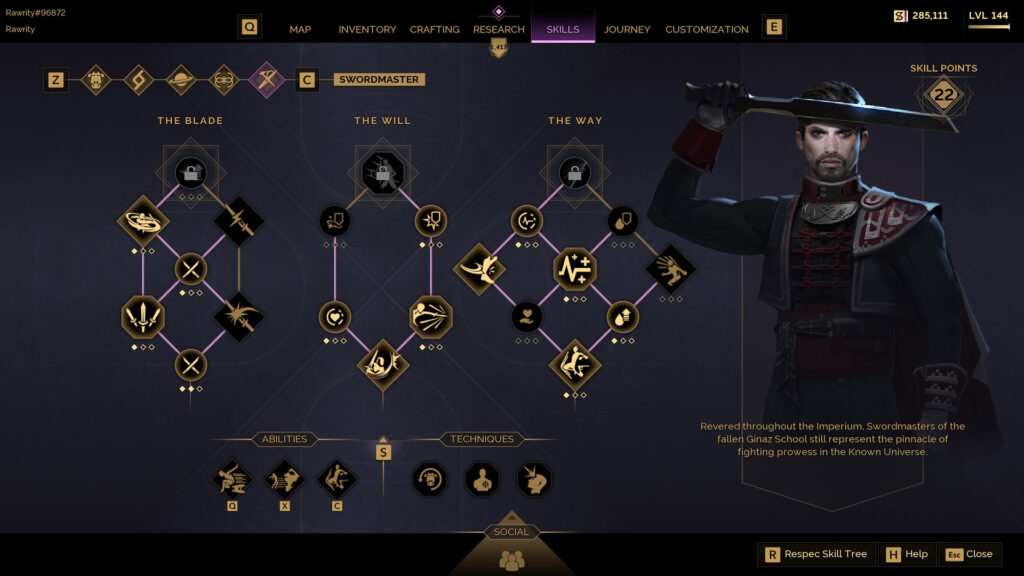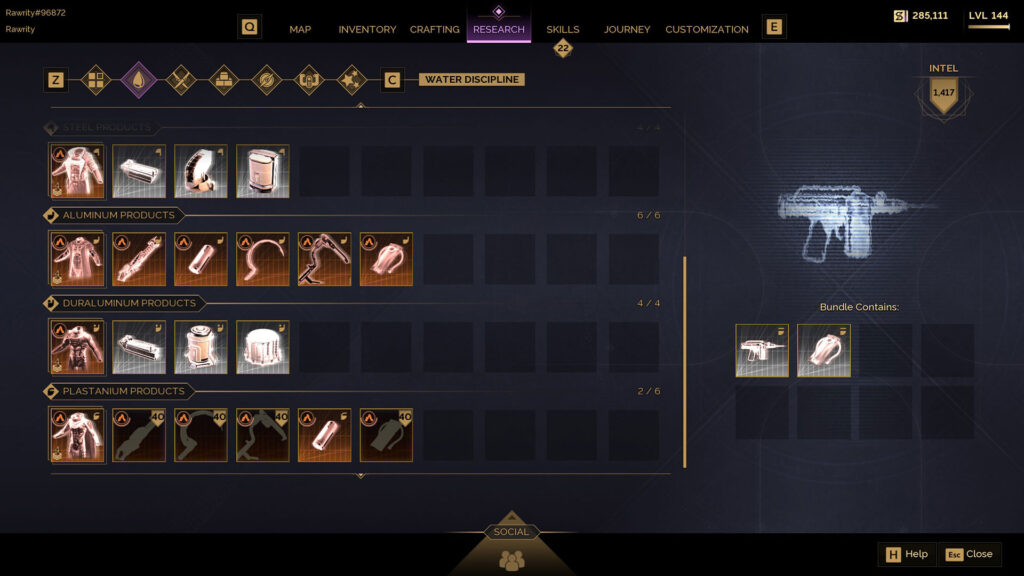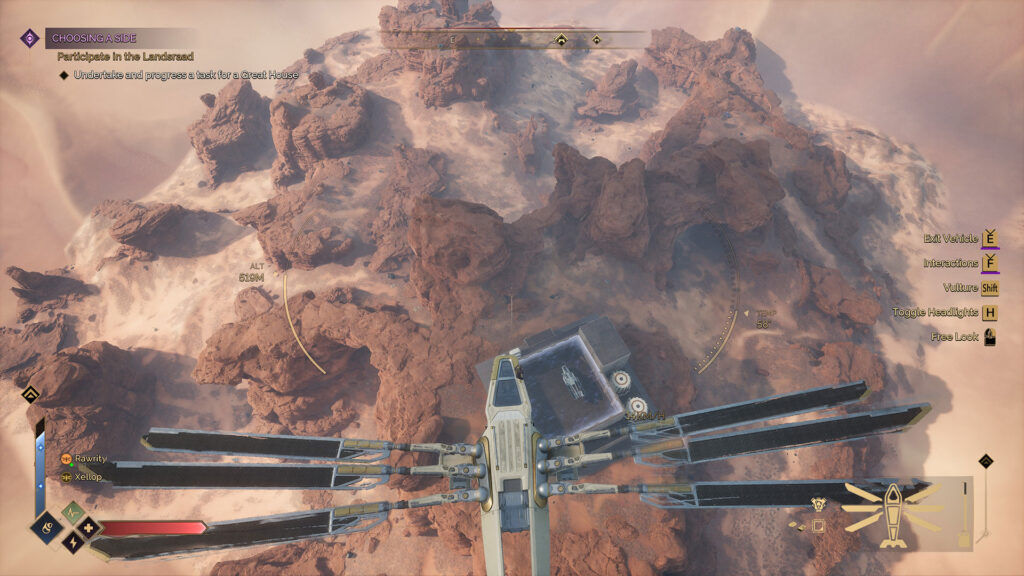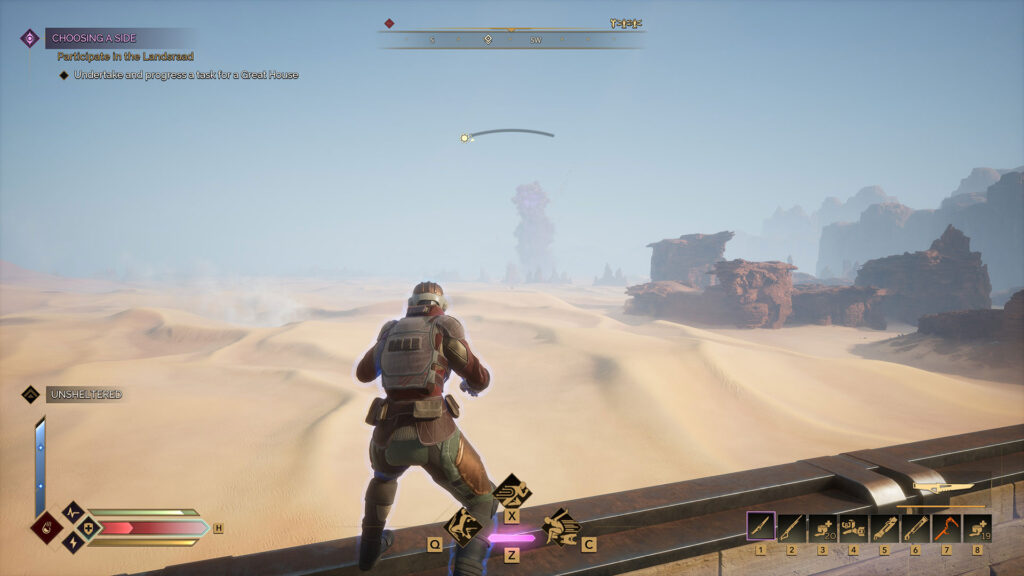Quick Verdict
When Funcom released Dune: Awakening’s first trailer, my initial thought was “Awesome, Conan Exiles with a Dune skin, I can’t wait.” As a group, we spent hundreds of hours in Funcom’s other survival game across multiple playthroughs, and despite its weird bugs, issues, and jank, we really enjoyed our time with it. The thing is, oftentimes with these licensing deals, some developers phone it in, and we wouldn’t have been surprised if all Funcom did was reskin Conan Exiles with Dune lore, assets, weapons, and equipment. Instead, we got something totally unexpected.
Like the planet Arrakis, Dune: Awakening is a massive game. Up until its release, I thought the entire idea of marketing it as an MMO was silly. To me, Dune: Awakening was going to be a crafting survival game similar to Conan Exiles or Ark: Survival Evolved, but I was very wrong. There is so much you can do in the game, whether you like to quest solo or explore with others. If you love the Dune universe and its lore, there’s plenty to delve into in this alternate world where Paul Atreides never existed. Dune: Awakening truly feels like a next-generation crafting survival game, blending meaningful gameplay elements you’d expect from an MMO, such as lengthy quest lines and exploration with resource gathering and tech upgrades. Even after the three of us have each spent around 90 hours in the game, there’s still plenty left to do.
Sandy Business

My first introduction to Frank Herbert’s Dune universe came at a young age through Westwood Studios’ Dune II from 1992. While the original Warcraft: Orcs & Humans is often attributed to making real-time strategy games mainstream, Dune II actually came before it and established many of the fundamentals found in the Warcraft series. Dune II was my first RTS and I absolutely loved it, serving as my gateway to Warcraft, StarCraft, and Command & Conquer. When I first played Dune II, I had no idea it was based on a book. It wasn’t until I was talking about the game at lunchtime in middle school that a friend shared that fact with me, lending me the book, and opening my eyes to sci-fi. It was also then that I realized one of the three Houses in Dune II, Ordos, was non-canon.
That game introduced me to the desert planet of Arrakis and the threat of a massive sandworm that would eat my spice refinery trucks when I wasn’t paying attention. It gave me an overview of the Fremen and the Emperor’s Sardaukar, while clearly differentiating the three Houses in the game by their units. Harkonnen gave the impression that it was more about brute force, while Atreides was focused on cunning strategy. House Ordos drew inspiration from the Mentat and were often described as insidious.
Why did I just spend all this time talking about Dune II? Well, that and the subsequent Dune 2000 have been the only Dune games I’ve ever enjoyed. We found Dune: Spice Wars to be pretty average and for the most part, the franchise hasn’t had any compelling video game adaptations. With the modern movies from Denis Villeneuve, Dune is mainstream and dare I say popular, and I’m so happy to claim that Dune: Awakening is by far the best game ever created based on Frank Herbert’s universe.
House Rules

Set in an alternate Dune universe where Paul Atreides was never born, Dune: Awakening doesn’t necessarily require you to be a fan of the books or the movies to enjoy the game. In fact, the person with the most played hours from our group of three has never watched any of the movies or read the books. The game has a surprisingly interesting story if you’re into the lore, and while it’s clearly non-canon, it draws from a lot of what is considered canon in the Dune universe. I’ll avoid going too deep into it here because of spoilers, but if you’re a Dune fan, this will be more than passable for you. If you’re not a fan, it’s interesting enough. I wouldn’t say the game focuses on delivering a top-tier narrative experience, but the folks at Funcom definitely took advantage of the IP.
The story sets your character on a path to survival on Arrakis and plays a big role for a crafting survival game. It all begins with the character creator that leads into the Gom Jabbar to determine your background, initial skill tree class, and more. Right away, Dune: Awakening accurately taps into the world of Arrakis, and while it does hold your hand initially, it doesn’t take long before you’re let off the rails. Once I was free to do as I wished, I quickly realized just how massive this game is. Funcom has created a very immersive Arrakis, one that manages to feel vast and empty, but also packed with content.
There are multiple ways to go about playing Dune: Awakening. If you want to play on your own, you can stick to the main quest line and all the Contracts that are available. This will get you exploring the giant world, meeting its characters, choosing a House to represent, and more. You will eventually need a base of sorts, since you’ll need to craft better equipment to survive the harsh conditions of Arrakis. But let me be clear: Dune: Awakening can be enjoyed solo. Even the late-game content in the Deep Desert can be tackled without others, but you’re obviously at a disadvantage since it is a PvP zone.
It’s a Worm’s World

As expected, one of the main features of Dune: Awakening’s gameplay is the constant threat of Shai-Hulud, the giant sandworms that don’t discriminate when it comes to its next meal. Traversing the open desert almost guarantees you’ll be eaten, forcing you to carefully hop from one point of interest to another, sticking to rocky cliffs and plateaus for safety. Generally, the game will give you ample warning before the sandworm surfaces to devour you, but sometimes it’s not enough. Navigating the terrain is an important part of Dune: Awakening’s early game, but this looming danger still remains even if you take to the skies with an ornithopter.
While it may feel like Shai-Hulud is a major inconvenience, its presence adds real tension and changes how you play. For example, there are certain resources that can only be gathered in the open desert, which means you have to stay on your toes and safely retreat when the sandworm approaches. I can confidently say the sandworm’s presence improves the game, because during a period in the Head Start when Shai-Hulud disappeared, we were able to freely roam the desert. Don’t get me wrong, this gave us a sense of relief, but it really took away a good bit of the tension.
Funcom deserves a lot of credit here, because the team managed to find a way to incorporate this massive threat to the world, without it feeling awful. Close calls feel great, and seeing the sandworm surface while you’re trying to build a new base is equal parts terrifying and entertaining. Shai-Hulud becomes less of an issue as you progress and gain access to an ornithopter, but you’re never fully safe. We know from experience: the sandworm is definitely capable of devouring an entire ornithopter. Getting eaten is punishing, as you lose everything on your character with no way to retrieve it. This includes vehicles, so it’s extremely important to stay aware of your surroundings and watch the warning meter when a sandworm is imminent.
Arrakeen Nights

When it comes to surviving on Arrakis, water is the main focus. Direct exposure to the sun impacts how quickly your water meter drains, which means staying in the shade is important until you’re able to carry plenty of water with you. Initially, getting water is as easy as drinking dew from plants in the world, but that caps at one-third of your total water bar. Eventually, you’ll be able to extract blood from fallen enemies and convert it into water. If you’re desperate, however, you can drink the blood straight from the blood bag. Like many games in this genre, water becomes much more manageable as you progress. You can equip a chest piece that slowly recycles water and acts as a separate container to drink from, along with a crafted container that stores additional water. At nighttime, you can use a Dew Scythe to gather water from the plants.
I noticed some similarities between Dune: Awakening’s early game navigation and V Rising. It was all about hopping from shaded area to shaded area, avoiding direct sunlight. Occasionally in V Rising, you also avoid certain areas of the map in case a boss is roaming around. In Dune: Awakening’s case, it would be avoiding the Shai-Hulud, which is always ready to feed. While nighttime does have its benefits with slower water drain, that’s also when the Emperor’s Sardaukar patrols the skies, sending down assassins if you’re caught in their spotlight. It’s all these threats that combine to give players the sense that Arrakis is a very dangerous planet. The giant, sprawling desert may seem empty at times, but it’s very much alive.
Compared to Conan Exiles, I didn’t find base building as important in Dune: Awakening. The main reason is that you’re very limited in the amount of land you can build on, because of the sandworm. In order to establish a base, you have to place a Sub-Fief that blocks out a certain build area. This area can eventually be expanded by using staking units, which come in two forms: one to expand the land area, and another to allow the base to grow vertically. Typically I love building massive bases in these types of games, but after a lot of trial and error, I found it more effective to build up. The game has a competent base building setup, with a good variety of foundations, walls, ceilings, and decorations. I definitely found the lack of a snapping grid to be frustrating, especially when trying to line up storage chests, and the snapping when trying to place foundations or walls next to each other was finicky. It really seemed like you had to aim the camera somewhere unintuitive for the next panel, but eventually I got used to it.
Spice Fever Dream

Combat is another major component of the Dune: Awakening experience and was one of my biggest question marks, given how janky Conan Exiles’ combat felt. Although combat is probably Dune: Awakening’s biggest flaw, I found it comparable to Starfield’s. Whether you take it as a compliment to Dune: Awakening or an insult to Starfield, the two experiences felt pretty similar to me. In Dune: Awakening, you can have up to three skills on your hotbar, though you can learn many more skills across all the different classes. There are a total of five classes in the game, four of which can be chosen from at the beginning: Swordmaster, Bene Gesserit, Mentat, Trooper, and Planetologist. The Planetologist is the only current class that requires progression in the game in order to unlock.
While each class has its own archetype, you can unlock them all and spend points across any skill tree. Creating hybrid builds is essential to being effective in combat, as many of the synergies come from across the different classes. Some active skills double as movement abilities and are mainly used out of combat for easier traversal. I found myself loving Bindu Sprint, which also saved me numerous times from being a sandworm meal.
You can choose to focus on ranged or melee combat, or a mix of both. For melee enthusiasts, just know that although Dune: Awakening includes a parrying system, it isn’t the most precise. The biggest criticism I have for the game’s combat is the lack of enemy variety. You won’t take long to see every enemy type, after which difficulty simply ramps up by packing more foes into smaller areas. As with many crafting survival games, Dune: Awakening’s combat lacks depth, but there is wide build variety thanks to its multiple classes and skills. It’s also worth noting that some combat skills feel a bit wonky in practice. For example, Knee Charge would sometimes send our character well past the enemy unit and leaving us in an unexpected, vulnerable spot.
Mind Tricks for Dummies

Now, considering Funcom also developed Conan Exiles, you’d think the overall UI would be polished. I didn’t find that to be the case; instead, I found some questionable design decisions. For starters, you only have one hotbar with eight options, which means constant swapping of tools onto your hotbar. It’s surprising that there isn’t an option to quickly swap to a second hotbar instead of clicking and dragging items onto your current one. Many things are buried within nested menus, and you can only track one main quest and one Contract on your HUD at a time. Since the game is marketed as an MMO and packed with dozens of quests and Contracts, I found it frustrating that you can only track two objectives at a time.
My general biggest frustration with the game was inventory management. Dune: Awakening chooses to have two aspects to control your inventory: the number of slots and overall weight. It means you can only hold so many unique items and so much weight—hit either cap and you can’t pick up anything else, even if the other limit isn’t reached. So, for example, you could have a single item in your inventory, but if it caps your weight, you can’t carry anything else. Conversely, if you hit the cap on unique items, you won’t be able to pick anything else up, even if your weight capacity isn’t maxed.
I understand the system exists to make surviving on Arrakis feel more realistic, but the current limits feel very restrictive. Early on, when it can be time consuming to go back and forth from your base to gather resources, it feels maddening how quickly you fill up your inventory. It’s also silly how heavy a filled blood bag is, compared to an entire corpse. The whole balance of inventory management feels off, and at the time of writing, there’s no way to increase any of these limits, despite the fact that MK5 and MK6 resources weigh a lot. Instead of it feeling better as you play more, it actually feels worse and more frustrating.
Dreams of Muad’Dib

With three of us diving into such a massive game, our list of criticisms doesn’t end there. There are no separate maps for buildings or caves you enter, which can leave you circling around and getting lost, since many of these areas share similar textures and aesthetic design. The overall map can also be hard to read, with dozens of icons packed together and elevation changes that make it difficult to pinpoint facility entrances. Even the ability to pan the camera on the map display would have been helpful, but instead we’re stuck with a bird’s-eye view.
Our biggest complaint comes during a main quest step where only one player can enter a locked area at a time. This quest can take up to 30 to 45 minutes to complete, resulting in a line of players waiting outside the door. We couldn’t join as a party, so each of us had to wait our turn while competing with other players trying to get in. For a game designed as an MMO—that is massively multiplayer online—gating quest progression behind an area that allows only one player at a time is simply asinine. Although the design is true to Dune lore, it makes for a very poor user experience. Please, Funcom, make that quest step instanced for every player. We can’t even imagine what the line is like now that the game has hundreds of thousands of concurrent players.
There are minor gripes too, such as the frustration of deploying vehicles and the odd physics of ornithopters. For a vehicle meant to function like a helicopter, it’s hilarious to watch it slide down the tiniest sand dune. Later, you’ll find depositing water at your base really tedious because there’s no deposit-all button. We spent ages clicking to deposit collected water, and later you’ll need large quantities of it to craft MK5 and MK6 items.
Bene-Obsessed-a-bit

In the past 10 days, each of us has spent at least 80 hours in Dune: Awakening, with one of us passing the 100-hour mark already. Funcom has created a massive world to explore, packed with things to do for all different playstyles. We’re now spending time in the Deep Desert, a largely PvP zone where MK6 materials are found and the threat of a giant sandworm looms more than ever. The area essentially resets every week and features half-off discounts on base building materials with full refunds upon disassembly. It’s an interesting mechanic that we’re looking forward to spending more weeks exploring.
We also haven’t dug deep into the game’s politics or how they impact the ongoing struggle between House Atreides and House Harkonnen. It’s impressive that even after all these hours, there are features of the game we haven’t fully explored. Each time we log in, we have a long list of tasks—whether gathering resources to tech up and build a spice harvester or completing quests to unlock additional skills from each class. Or maybe we just need more Solaris, so we complete as many Contracts as we can.
Dune: Awakening doesn’t just feel like a next-generation crafting survival game—it feels surprisingly polished. Sure, there are some issues with the game and it has its fair share of jank and odd glitches here and there, but in this genre, many would say it’s part of the charm. The level of exploration did remind me a bit of Tears of the Kingdom, with its verticality and depth. There’s so much to uncover in Dune: Awakening that I now understand why Funcom sees it as an MMO. If this is the direction the crafting survival genre is heading, though, sign us up. It’s a true evolution I never thought I would see, and I’m so happy Arrakis is the backdrop. It’s a content feast worthy of Shai-Hulud and a complete steal at $49.99.
Dune: Awakening has an official release date of June 10, 2025, for PC. This review is based on three retail codes provided by Funcom on PC. While FullCleared has affiliate partnerships, these do not influence our editorial content. We may, however, earn commissions for products purchased via affiliate links.


